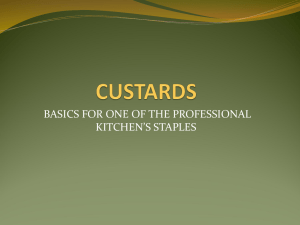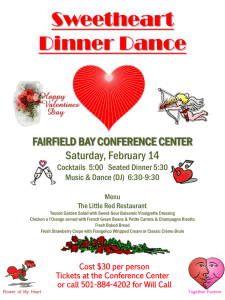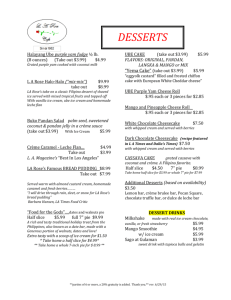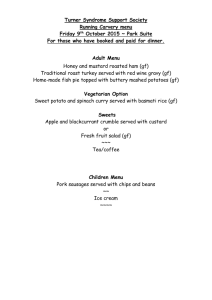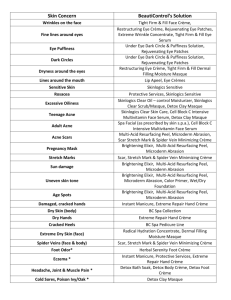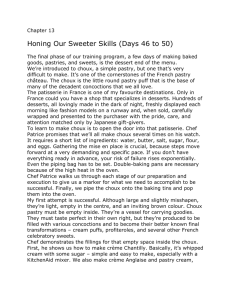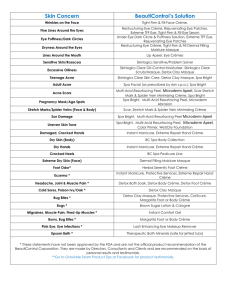Session 2 Custards
advertisement
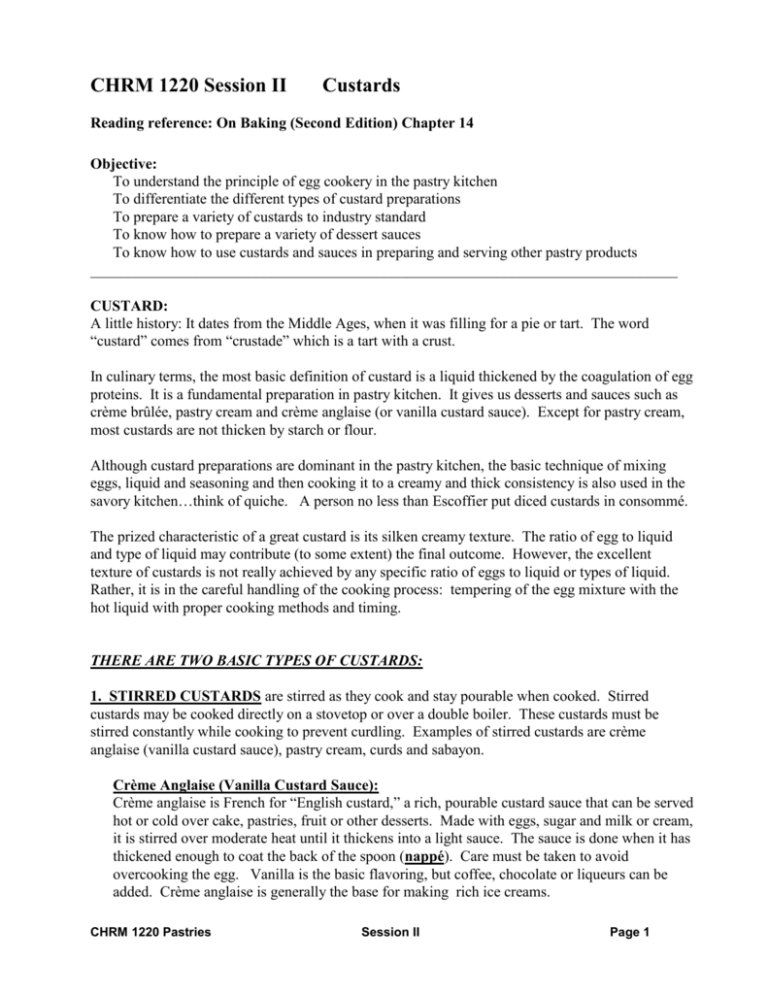
CHRM 1220 Session II Custards Reading reference: On Baking (Second Edition) Chapter 14 Objective: To understand the principle of egg cookery in the pastry kitchen To differentiate the different types of custard preparations To prepare a variety of custards to industry standard To know how to prepare a variety of dessert sauces To know how to use custards and sauces in preparing and serving other pastry products ______________________________________________________________________________ CUSTARD: A little history: It dates from the Middle Ages, when it was filling for a pie or tart. The word “custard” comes from “crustade” which is a tart with a crust. In culinary terms, the most basic definition of custard is a liquid thickened by the coagulation of egg proteins. It is a fundamental preparation in pastry kitchen. It gives us desserts and sauces such as crème brûlée, pastry cream and crème anglaise (or vanilla custard sauce). Except for pastry cream, most custards are not thicken by starch or flour. Although custard preparations are dominant in the pastry kitchen, the basic technique of mixing eggs, liquid and seasoning and then cooking it to a creamy and thick consistency is also used in the savory kitchen…think of quiche. A person no less than Escoffier put diced custards in consommé. The prized characteristic of a great custard is its silken creamy texture. The ratio of egg to liquid and type of liquid may contribute (to some extent) the final outcome. However, the excellent texture of custards is not really achieved by any specific ratio of eggs to liquid or types of liquid. Rather, it is in the careful handling of the cooking process: tempering of the egg mixture with the hot liquid with proper cooking methods and timing. THERE ARE TWO BASIC TYPES OF CUSTARDS: 1. STIRRED CUSTARDS are stirred as they cook and stay pourable when cooked. Stirred custards may be cooked directly on a stovetop or over a double boiler. These custards must be stirred constantly while cooking to prevent curdling. Examples of stirred custards are crème anglaise (vanilla custard sauce), pastry cream, curds and sabayon. Crème Anglaise (Vanilla Custard Sauce): Crème anglaise is French for “English custard,” a rich, pourable custard sauce that can be served hot or cold over cake, pastries, fruit or other desserts. Made with eggs, sugar and milk or cream, it is stirred over moderate heat until it thickens into a light sauce. The sauce is done when it has thickened enough to coat the back of the spoon (nappé). Care must be taken to avoid overcooking the egg. Vanilla is the basic flavoring, but coffee, chocolate or liqueurs can be added. Crème anglaise is generally the base for making rich ice creams. CHRM 1220 Pastries Session II Page 1 Pastry Cream (crème pâtissière): It is made of egg yolks, sugar and cream or milk like crème anglaise, but the addition of starch gives it the stability to be brought to a boil. This custard must come to a boil to fully gelatinize the starch as well as to cook out the raw taste of starch. Pastry cream is typically flavored with vanilla, although other flavors can be used. It may also be lightened with the addition of whipped egg whites or creams. Frangipane: Almond custard filling, a thick type of crème Pâtissière mixed with powdered almonds. It is used as a filling for tarts or crêpes. Curd: Not really a custard because it lacks cream, curd is made from fruit juice, typically citrus, plus sugar, eggs and butter. It is used to fill tarts, as a spread and as a base for mousse. Sabayon (Zabaglione, Italian version): It is a mixture of egg yolks, flavoring and sugar, beaten over simmering water until thick then beaten until cool. The Italian version is Zabaglione which is flavored with sweet wine, generally marsala. It is often served warm over fresh strawberries or grilled over fruit (when it is called a gratin). Sabayon is the base for mousses and buttercreams. 2. BAKED CUSTARDS. Baked custards are almost always cooked in a bain marie and generally covered so they don’t develop a “skin”. Another crucial point to learn is to cooking them with gentle heat and for the right amount of time…knowing to remove the custards from the oven when they still jiggle in the center and let carryover-cooking finishes them is crucial. Three classic French custards: crème brûlée, pot de crème and crème caramel. All three are made of eggs, sugar, milk and/or cream, along with a flavoring such as vanilla. They share the same mixing and baking technique but produces different results because of their varying proportions. Crème Brûlée: The richest and thickest of the three. It is made of all heavy cream and egg yolks, and is topped with a brittle layer of caramelized sugar (brûlée is French burnt, crème brûlée means “burnt custard”). The sugar is usually burned under a salamander or by a kitchen torch. Crème brûlée can be served cold or warm, and is usually served in individual ramekins. While the traditional custard base is flavored with vanilla, variations include chocolate, teas, nuts, spices/herbs and liqueurs. Pot de crème: This custard is eggy, soft and smooth. Generally, it is made with mix of cream and milk and high proportion of egg yolks. It is spooned and eaten plain or with a dollop of whipped cream. Crème Caramel or Flan: The lightest of the three classic French custards, crème caramel is made with whole eggs as well as yolks, milk as well as cream. Caramel syrup is poured into the CHRM 1220 Pastries Session II Page 2 mold or ramekin before adding the custard base. After the custard has set, it is unmolded, leaving the caramel sauce on top and pooling around it. Crème caramel usually cooks faster than the other custards because of the extra egg whites because white proteins coagulate at a lower temperature than egg yolks. Also due to the egg whites, crème caramel is stiff enough to stand on its own. Crème caramel came to the U.S. in the 19th century via New Orleans, but did not become popular until the 1980s when it was introduced by French chef Alain Sailhac of New York’s Le Cirque restaurant. Flan is a version of crème caramel in Spanish and Latin American countries. It is the national dessert of Spain. In Mexico, dulce de leche is often used instead of caramel syrup. Soufflé: A sweet or savory preparation consisting of a custard base lightened with whipped egg whites. During baking, air cells in the whipped white expand to create a light and airy product. Cheesecake: This is essentially a baked cheese custard. Ancient Greeks devised the first known recipes. American revolutionized it with the development of cream cheese in 1872. In Europe, the cheese is usually ricotta, crème fraiche or farmer’s cheese. Bread Pudding: It is a home-style dessert with chunks of bread, flavorings, raisins or other fruits mixed with the custard and bake. Quiche: A savory custard that may include other ingredients. The classic Quiche Lorraine has onions and Emmentaler cheese. A royale is a plain savory custard with no other added ingredients. COMMON DESSERT SAUCES Crème anglaise: principal dessert sauce Fruit couli: sweetened thick sauces with strong flavors and colors. Caramel sauce: mixture of caramelized sugar and heavy cream Chocolate syrup: Add finely grated or chopped chocolate to a warm vanilla custard sauce. SUGAR COOKERY Wet or dry cook sugar. Difference: ??? Avoid stirring after sugar comes to boil. Wet cook: 1. Use a heavy clean saucepan. Stir to make sure that all sugar dissolves before it reaches a boil. DO NOT stir after it starts boiling. 2. Add acids or inverted sugars when boiling to prevent sugar crystal formation. 3. Brush down the sides of pan with cold water to wash away crystal buildup and to avoid additional crystals. Cook to desired temperature. CHRM 1220 Pastries Session II Page 3 CHRM 1220 Pastries Session II Page 4
